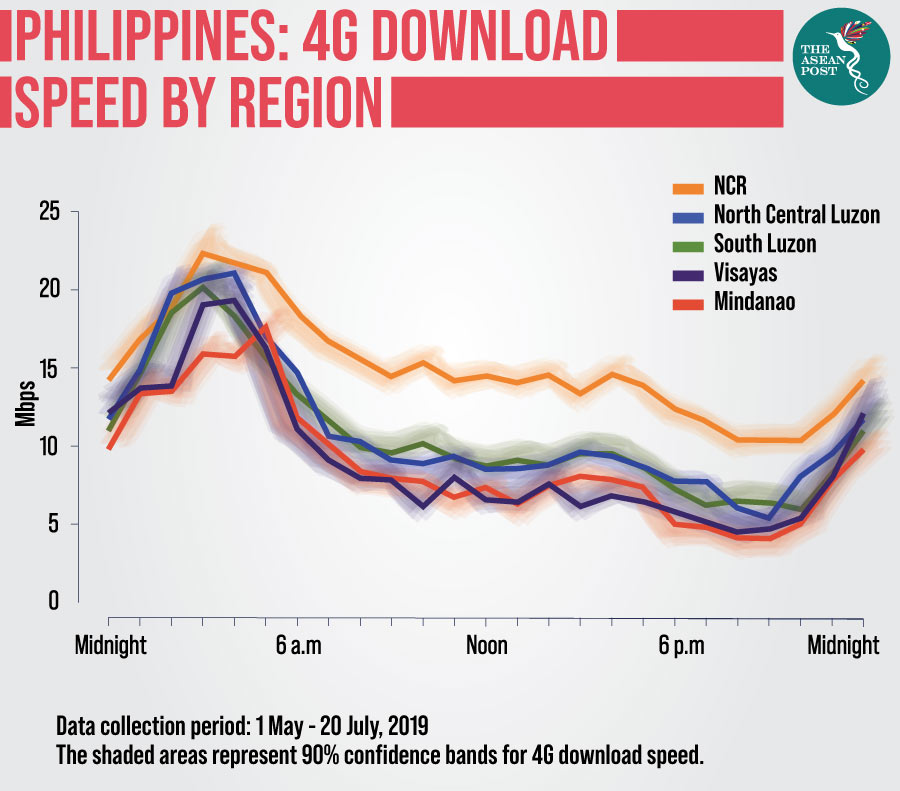Not all 4G wireless users are created equal. This was what Opensignal - a London-based company that specialises in mapping wireless coverage – found out recently when it analysed the fluctuations in 4G download speeds that its users in the Philippines experience throughout the day across different regions.
In its recent 5G Opportunity report, Opensignal analysed the wide fluctuations in 4G download speeds experienced throughout the day on networks in 77 countries around the world. The Philippines showed particularly large variations, with speeds 2.8 times as fast when experienced at the fastest hour of the day.
The company found that while all users in the Philippines experienced similar speeds at quiet times at night, bigger differences between regions emerged during the day when networks became busy. Users in Metropolitan Manila – the National Capital Region (NCR) – experienced significantly faster speeds at congested times.
This was based on data collected from 1 May to 30 July from five different regions in the country: NCR, North Central Luzon, South Luzon, Visayas and Mindanao.
All five regions showed similar trends but to a varying extent. The 4G download speeds users enjoyed were at the fastest across all regions between 3 a.m. and 5 a.m., fell significantly afterwards, then continued to gradually decrease across the rest of the day – reaching the slowest speeds in the evening – before finally jumping back up in the middle of the night.
NCR showed the least speed fluctuation of 12 megabytes per second (Mbps) between fastest and slowest 4G download speeds within a day, while users in North and Central Luzon experienced the greatest range with a difference of 15.7 Mbps between quiet and busy times.
At night, when most people are asleep and fewer devices connect to mobile networks, speeds experienced by users across regions reached 17 Mbps or more in 4G Download Speed, with no single region shining above the others. According to Opensignal, this suggests that networks in all regions are capable of delivering a faster experience when there are fewer people using the network.

Fostering equality
The idea that the more people who are using a network will result in slower speeds is pertinent in ASEAN. According to We Are Social, as of January 2019, internet penetration in ASEAN reached 65 percent and this number is only growing.
But this is more than simply a question of internet penetration. It is also a question of equality. As Opensignal points out, there are obvious differences in connectivity speeds between different regions. The slowest speeds were present in Visayas and Mindanao.
Take a deeper look at these two regions and we see a pattern emerge. According to the World Bank, Mindanao accounts for a third of the Philippines’ poor at only a quarter of its population. Meanwhile, the Philippine Statistics Authority found that three in every 10 families in Eastern Visayas are poor.
It is a widely accepted idea that internet connectivity provides important opportunities that would otherwise be absent to the less fortunate. But if Opensignal’s findings are anything to go by, it seems to be usually those who are better off who are provided that stream of opportunity.
The answer to this dilemma is to make the move to 5G.
5G networks will provide the solution to internet congestion as the technology is built using new high bandwidth, high-frequency spectrum bands that help mitigate the daily cycle of congestion seen on today's 4G networks. These 5G services will support more simultaneous users at very fast speeds.
Moreover, according to Bain & Company, a global management consultancy headquartered in Boston, 5G-capable devices will seamlessly – and nearly instantly – connect to 4G cells when they cannot get a 5G signal. This will allow operators to “deaverage” their approach to cell building and fine-tune the creation of new cells to specific areas with the highest demand density.
Opensignal senior technical analyst Francesco Rizzato notes that while mobile networks in the capital appear to cope better with heavy usage at busy times, congestion continues to be a nationwide challenge.
“The massive variation in users’ mobile network experience across the day could ultimately place severe restrictions on the type of applications and services consumers can access and damage users’ perceptions because they will experience great mobile speeds at some times of day but not at others.
Mobile operators should try and improve their users’ experience at busy times of day when many users are transmitting data, and in some areas, creating congestion. The deployment of 5G networks and additional spectrum will provide much needed capacity, and in turn enable users to experience faster speeds at busy times,” he said.
Related articles:
